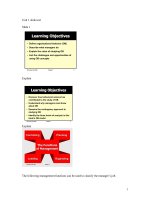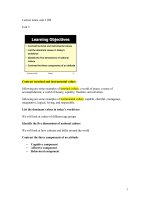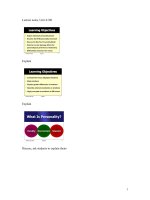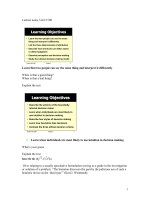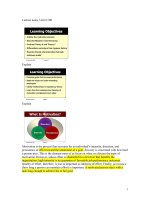Organizational behavior: Lecture 20 - Dr. Mukhtar Ahmed
Bạn đang xem bản rút gọn của tài liệu. Xem và tải ngay bản đầy đủ của tài liệu tại đây (515.21 KB, 55 trang )
Organizational
Behavior
(MGT-502)
Lecture-20
Summary
of
Lecture-19
Group Problem Solving Techniques
• Consensus presenting
opinions and gaining agreement
to support a decision
• Brainstorming process to
generate a quantity of ideas
• Nominal Group Technique
process to generate ideas and
evaluate solutions
• Delphi Technique process to
generate ideas from physically
dispersed experts
• Computer-Aided Decision
Making
Decision making model
1. Identify
problem
6. Evaluate
decision
2. Choose
decision
style
5. Implement
solution
3. Develop
alternatives
4. Choose
best solution
How involvement improves
decisions
Leads to better
definition of
problems
Employee
involvement
Improves number
and quality of
solutions
More likely to select
the best option
Other Consequences of
Group Decision Making
• Diffusion of Responsibility
• Group Polarization
• Potential for Conflict
•
•
•
•
•
•
Organizations Can
Facilitate Creative Decision
Making
Reward creativity
Allow employees to fail
Make work more fun
Provide creativity training
Vary work groups (internal/external)
Encourage creative stimuli (music,
art, etc.)
Ethics Check
• Is it legal?
– Does it violate law
– Does it violate
company policy
• Is it balanced?
– Is it fair to all
– Does it promote win-win relationships
• How will it make me feel about myself
Today’s Topics
Communication Defined
The transmission of
information and
understanding through
the use of common
symbols.
The Importance of
Communication Skills
“Top executives from Fortune 500 companies
rate communications skills as the most
important quality for business leaders.”
New York Times
Business Section
“There may be no single thing more important in
our efforts to achieve meaningful work and
fulfilling relationships than to learn and practice
the art of communication.”
The Art of Leadership
Max De Pree, Author
The Communication
Process
Encoding
Channel
Message
Decoding
Message
Source
Receiver
Feedback
Encoder
Participants
Sending Channel
Encoder
Decoder
Meaning
Encoder
Participants
Sending Channel
Encoder
Decoder
Meaning
Meaning
Decoder
Participants
Feedback Channel
Encoder
Context
Context
Sending Channel
Noise
Encoder
Decoder
Noise
Meaning
Meaning
Decoder
Participants
Encoder
Feedback Channel
Context
Context
The Communication Process
Noise
Decodes
Sender
Decodes
Message
Encodes
Receiver
Encodes
Feedback
Noise
– Interference in the flow of a message
from a sender to a receiver.
Nonverbal
Communication
– Messages sent with body posture, facial
expressions, and head and eye
movements.
Nonverbal Communication
Body Motions
Body Language
Facial Expressions
Tone of Voice
Paralinguistics
Pacing and Pitch
Territorial Space
Territorial Space - bands of space
extending outward from the body; territorial
space differs from culture to culture
a = intimate <1.5’
b = personal 1.5-4’
c = social 4-12’
d = public >12’
a
b
c
d
Seating Dynamics
Seating Dynamics - seating people in certain
positions according to the person’s purpose in
communication
X O
Cooperation
O
X
Communication
X
O X O
Competition
NonCommunication
O
How Communication
Works
Communications experts tell us that
effective communication is the result of
a common understanding between the
communicator and the receiver. In fact
the word communication is derived
from the Latin communis, meaning
“common.”
Barriers to Effective
Communication
Barriers to Effective
Communication
• Filtering
– refers to a sender manipulating information so that it will
be seen more favorably by the receiver.
• Selective Perception
– Receivers in the communication process selectively see
and hear based on their needs, motivations, experience,
background, and other personal characteristics.
• Defensiveness
– When individuals interpret another’s message as
threatening, they often respond in ways that retard
effective communication.
• Language
– Words mean different things to different people.
Cross Cultural Barriers To
Communications Include
• Time
• Location
• Space, other body language
• Touch
• Eye contact


